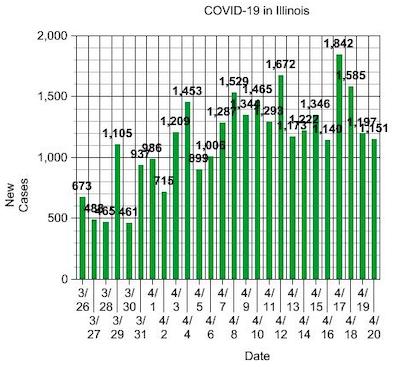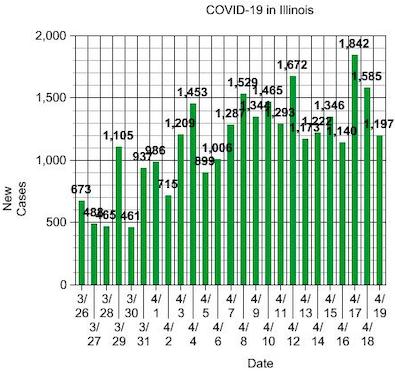* The governor started his press conference by looking at hospitalization history. On April 6, Illinois hospitals had 3680 COVID-19 patients….
On April 10, that number had risen to 4020. On April 14, that number had risen to 4283. And as of April 19, we had 4599 Illinoisans in the hospital with COVID-19. That’s a net increase of 316 from April 14.
For context, early modeling in mid March, showed that without social distancing we would have exceeded our hospital capacity by more than 25,000 beds by April 6.
And to be clear we are still seeing too many Illinoisans hospitalized with this virus, but because Illinoisans have come together by social distancing learning at home and staying at home, we’ve so far prevented our worst case scenarios.
Please pardon all transcription errors.
* ICUs…
On April 6, COVID patients occupied 43% of our 2700 ICU beds. On April 10, that number was 40% of 2900 ICU beds. Remember our institutions have worked to expand their bed capacity, which is why our overall bed number keeps increasing.
On April 14, COVID patients occupied 40% of the nearly 3000 ICU beds. And that brings us to today. Of the 4599 Illinoisans in the hospital with COVID-19 right now, 1239 of them are in the ICU, occupying 40% of our now 3100 beds.
* Ventilators…
Of the 4599 Illinoisans in the hospital now, 757 are on ventilators. That means 23% of our total ventilator inventory is currently in use by COVID-19 patients, continuing a downward trend from 25%.
On April 14, 27%. On April 10, 29%. On April 6, and I’ll add that 23% of our total ventilator supply is about 10 percentage points lower than it would have been had Illinois not acquired about 1000 ventilators since March 23. When we had about 2200 ventilators statewide today. We’re up to 3200 ventilators.
Again, had we not established mitigation measures by now we would have needed thousands more ventilators beyond our existing capacity.
So real progress has been made. And while we never know the exact impacts of the efforts. All of you have made to protect your communities, all the projections indicate that you have saved thousands of lives.
* Peak? No…
But as you’ve seen our case numbers in our hospitalizations are still rising, even if that rise is slower now, our curve is bending the right way.
With the current mitigation strategies in place we may not have reached our peak yet, but your actions are helping to keep that peak as low as possible.
* Nursing homes…
On February 28, in my first public update dedicated specifically to the coronavirus, I highlighted that the data from other countries clearly showed that COVID-19 tends to cause more serious illness in elderly populations. And on March 4, five days before we initiated our disaster Proclamation, we established guidelines to maximize preparations at our nursing homes veterans homes and long term care facilities, long before the first nursing home case appeared in Illinois, the state implemented strict measures around restricting visitors at the long term care facilities that we operate such as the veterans homes at DHS facilities. And we collaborated with [inaudible] associations to have the facilities that we regulate implement similar strict guidelines.
He went on to detail more of the history of what they’d done.
* With increasing supplies of testing supplies, the administration has expanded testing…
First, let’s discuss facilities without known COVID-19 outbreaks. We’re working to test all residents and all staff at those homes. We’re prioritizing testing current long term care facilities that are home to our populations where COVID infection is more likely to lead to higher severity cases, especially among black and brown communities. This testing at non COVID facilities will allow us to identify early the presence of COVID-19 in a facility and isolate those cases before widespread transmission.
With support from the Illinois National Guard and the Illinois Department of Transportation, our teams delivered tests to our first two homes over the weekend. And we’ll do the same for an additional 10 facilities today, with more to come.
Second, in facilities with known COVID-19 cases, we continue to operate under the assumption that our resident displaying symptoms of COVID-19 has COVID-19, and should be isolated accordingly and receive the appropriate care.
One change, however, is that we’ve altered our protocol related to staff. In prior weeks we’ve advised that staff be given pre-shift wellness checks, including taking temperatures. We will now be ramping up testing on all staff who work at these facilities, all staff, allowing us to determine who is coming in and out of an infected home, possibly asymptomatic and should instead be at home in isolation. This will be critical to our work to prevent further spread at these facilities.
* Warns nursing home operators…
I briefly want to address concerns about long term care facilities not adhering to proper COVID-19 response protocols. Thus far facilities seemed to have been responsive to IDPH guidance and compliance with IDPH teams on the ground. Just like our other health care workers staff at these facilities are frontline workers dedicating their days and nights to caring for seniors and doing all that they can to ensure a safe and healthy home for their residents. We as a state are deeply grateful for their service.
That said, we will not hesitate to hold any bad actors at the management level accountable. These private facilities are home to some of our most vulnerable Illinoisans, and we expect owners and managers responsible for their care to take every action at their disposal to keep them safe.
* Dr. Ezike…
Again the testing is just one of the elements of our plan, as the governor explained. Along with the testing we also provide education and stakeholder engagement. Again this is a partnership with the owners and staff at the nursing homes and the long term care facilities.
We’re also working closely with the local health departments, the local health departments are the first public health entities that come in contact and assist at the long term care facilities. IDPH also assists all of those entities by providing weekly webinars, and also twice weekly calls monitoring and surveillance, obviously is very important and that’s the primary role of the state. We have the identification of the positive cases through our electronic lab reports that come to us. And also we have an outbreak reporting system.
The third element is for local health departments and long term care facilities to implement our infection control guidance and as the governor mentioned before we ever had a case, we worked to come up with a very intense set of guidances, including the pre-shift assessments, in signage, making sure that visitors were restricted. And so making sure that local health departments can request technical assistance from IDPH we have that ongoing. And again, as mentioned, we have a team of infection control preventionist, as well as infectious disease doctors that are able to be deployed.
We also have enhanced engagement as another another part of our plan. And this involves identifying when there are persistent problems. This could be dealt with with more on site monitoring and also more visits from our infectious disease doctors or infection control specialists.
And then finally there’s another arm to this, which is resident reengagement. And that just has to deal with how we manage residents that are coming, who were at long term care facilities that went to a hospital, and then are trying to be returned to long term care facilities.
* Dr. Ezike also explained “the challenges with reporting data in real time for these facility outbreaks”…
To start, obviously, data is coming in to our systems hourly. So, the facility is probably the best place to get the most up to date data. But we are pulling data from two different electronic reporting systems, one is the … the national electronic disease surveillance system. And the second is our outbreak reporting system. So the local health departments and hospitals will put data into those into those electronic systems and it’s from there that we can aggregate the data and be able to share the data that’s been put into our system. To help preserve the integrity of the data as much as possible when trying to report in real time, IDPH posts data as was reported from the day before so there would be a lag. And because data is continually being updated, we are going to have the data up on our website, and we will update it once a week. And of course, the information that we pull out had to have been submitted, so lag from from the local health department, we can only report obviously what we’ve been given.
So I know it sounds like a straightforward, but it’s a little complex. We’re dealing with multiple reporting systems and a lot of players who have to put the information in. But we at IDPH are doing all that we can to make sure that we share all the information that we can while also being responsible and trying to protect individuals privacy rights. We know that this is a different time, and some of the requests go further than what we have ever done in the past and so we have to try to navigate that line and not veer too much and not also compromise the privacy of the individuals.
* On to questions for the governor. How accurate are those nursing home numbers?…
Dr. Ezike: They’re as accurate as the information that’s put into it. We’re not in the nursing homes collecting the data, we are receiving the data from outside inputs. And so that’s what we’re putting out. The data is as good as the data that went in.
* Some nursing homes are saying no thank you we can’t have you back, even if you’ve recovered…
We are working through that. That’s been an issue where we’re working to identify the ways that nursing home residents, long term care facility residents can get back to their home, if you will. And so trying to figure out the right time when it’s safe for them to come back, when it’s deemed that they’re no longer infectious. We’re working between the hospitals and the facilities to be able to identify that time and get people safely back to their permanent residence.
* Governor were you on the call today with Vice President Pence. How did that go and what was the main focus of that call?…
The main focus of that call was about testing. The White House’s reiterating … the coronavirus Task Force is reiterating that states have testing capacity. And I’ve said this before, but you know testing capacity is a function of how many machines do you have and if you ran them 24 seven. What output, could you get?
The problem is there’s a big difference between testing capacity and getting testing results, and what’s the big difference all those things in between that you need, like swabs, and viral transport medium and RNA extractor reagent. And then you’ve got to run those machines with lab techs, and if you’re going to run them 24 seven, that’s three shifts.
So, what they really have said is hey you’ve got plenty of machines out there, go to it. And what all … the other governors who spoke, republican and democrats, really said the same thing which is, we all need swabs, we all need VTM. We all need RNA extractor and reagent.
* There was a shipment that didn’t arrive that you had ordered. What about that, are there is some criticism from the White House, that they say you have not been truthful about the resources from the feds. And yet you spent 174 million on getting, and obviously not just that one shipment but did you have to go that far, and that expensive to get what you need…
Yes. And the reason is because the White House has not delivered what it has said it would deliver. Let me explain what they are taking credit for.
You may have heard of this thing that they’re calling the air bridge. It’s really just an airplane that they’re bringing from China on a regular basis. Bringing goods to the United States PPE. Which sounds terrific, except for one thing.
When they land at O’Hare Airport, those goods don’t come to the state, or to the cities. They go to distributors, some of it goes to the White House or the federal government, and they keep it, but some of it, much of it goes to the distributors, the profit making private businesses distributors who are getting the government to deliver to them, their goods from China, because they can’t get them out of China, and then they get to decide where those goods go.
So what they’re taking credit for, the White House, is that the distributors have customers in Illinois that they’re sending goods to, because those customers ordered those items of PPE. So that’s a far cry from delivering to the states so that we can distribute to for example, a nursing home that has an outbreak. That’s not what’s happening. What they’re doing is delivering to for profit businesses that are selling for profit to their prior customers who have ordered things from them.
* Univision: How much testing do we need to say okay it’s time to reopen the economy?…
Look, there’s not an exact number, but I would tell you this, that you need a lot more testing than we have today.
And the reason I say it that way, I’m saying not an exact number because you can debate this question. I would argue that as we start to think about it, remember you need a lot of other preconditions even according to the White House model of how to move into phase one of what they’re calling reopening. You have to get past the peak you know you have to have 14 days of numbers going down right all those conditions.
But on the testing front, I would ask you this question: What would make you feel comfortable going back into your place of work. How much testing [of] other people work with you, near you? How much what would you need to feel comfortable as you go to work every day knowing that everybody in your workplace goes home, and they go to, the grocery store and they go to wherever it is they go visit their grandmother and so on? And then they come back to work the next day. And so I would suggest to you that, no, we don’t need to test everybody every day in every workplace, but it’s a lot more than just one test for each person because you would need to test. I’ll give you an example of a nursing home you would want to test the people who work there every day.
* WGN: We’ve received many calls and emails from viewers concerned about their employment claims haven’t been processed and can’t get through they are also, if they want an update, and where it all stands. Some are concerned about bills getting paid. So what’s the latest on the backlog?…
Well hundreds of thousands more claims have been processed since the last time that we gave you an update and our plan is a little later this week to give everybody a full accounting of where we are, but we’ve got the pace of processing up significantly from where it was, again, easier for people to get processed online than they can on the phone. But again we’ve increased the number of people answering phones, the number of phone lines and brought in outside help to do that. We’ll give you an update on that in just a couple days.
* WCIA: Dozens of grocery store workers have died from coronavirus despite temperature checks, capacity restrictions. So far, supermarkets have resisted banning customers from coming inside. What is your advice?…
Well, I’m not the doctor who can provide the advice. But I will tell you that it is of grave concern to me when people are gathering in close proximity, anywhere, and that is happening, most obviously anyway at grocery stores. And so we have a number of very good actors honestly out there who are doing the right thing, putting markers on the floors about staying six feet apart, they’re asking people to wear masks when they come in even maybe requiring it.
And there are also actors out there who are not doing that. And that has led me to think hard about whether we should require people to wear masks when they go to public places like that, because if you’re not wearing a mask and you’re not keeping socially distance. I mean those two things together, lead to people getting sick.
* You’ve been thinking about that for a while when are you going to decide?…
Well we’re trying to put it together with the other things that we want to change about our stay at home order.
But we also want to make sure that it’s understood properly, that this shouldn’t stop somebody from taking a walk in their local park if it’s open. You know that’s not the idea you know, we don’t want to stop people from going outside and enjoying the outdoors, without a mask if they’re not going to be in a public place with others. But when you’re in a public place with others or you think you are going to be, you should carry a mask wear a mask with you.
* WIND: In Missouri, for instance, the state is slowly opening May 4 with different phases for different counties. Might that be the case here? The governor there is saying okay, the mayors of St. Louis and Kansas City, they’re going to extend their stay at home order. Is that something you and Mayor Lightfoot might consider county by county rather than an entire state order?…
Well, Mayor Lightfoot doesn’t have any do with the other counties or other cities but. But I would say that as we make decisions about changing the stay at home order, or how we can even after the peak, how we might phase in people getting back to work or people reopening things.
I absolutely think that we need to look at where the capacity exists for example, if the hospital capacity in a certain area is quite large and very available. Even with coronavirus in existence, then that might be a place where you could do more, than some other place, but what’s most important though is keeping people safe and healthy. And so we’re trying to get, think about, there’s a lot of distances, you can imagine, between people’s homes in rural areas of Illinois. And so, you know, the idea of people going outside and wearing a mask, you know, on a property of theirs that might be 100 acres or 10 acres you know is much different than the prospect of somebody you know on the north side of the west side of Chicago, or going outside and walking on the sidewalk with hundreds of other people.
* Is a county by county idea something you are considering?…
Or region by region. I think the important thing is that that we want to keep people safe and and also give them the ability to do as much as possible without spreading the virus. And so those are the complications. None of this is done on a whim. All of this is done listening to the people who understand the virus and know how it gets transmitted. Even they’re learning as you know this is so new that some of the guidance that they’ve given to us who are, you know, less informed, right, the experts giving advice, have been learning along the way and giving more and more advice. You’ve seen CDC, for example, evolve the way they advise us. And so we’re trying to follow that advice and look at how best to give people the most freedom, while also making sure people are healthy.
* With 10 days left in that order might be here this week on whether it will be lifted changed altered whatever your plan is?
Again, a lot of this has to do with looking at every aspect of the order and seeing all the things that we might change we’re looking at it working on it every day. I promise you that I will be out here, you know, and tell you as soon as I can.
* The number of test results reported today is a little over 5000. When will we see that number go up permanently as a result of all the testing capacity increases you announced on Thursday? Have all of the Abbott rapid test machines been delivered to health centers, prisons and DHS sites and are they up and running? What about reports that Abbott test results have false negatives?…
[Instead of tests] let’s just use the word specimens, and testing results.
So, as you know you need those other items that I talked about earlier, in order to actually get a test result, you need the machine and all the items that it takes to get the specimen into the machine, and of course to take the specimen. So, my optimism about testing has been that we’ve been able to obtain sufficient or, you know, quantities anyway I wouldn’t call them, you know, abundant, but we’ve been able to obtain more quantities of each of those items and we have those. And then you’ve got to distribute those to everybody who needs them and make sure that they’re running tests. So all of that is a process that really has never before been run by the state of Illinois. That’s usually run by commercial labs or run by individual hospitals […]
My staff knows that I’ve been pushing to make sure that all of these sites are doing as much testing as possible and that we get those tests run. So my hope is again I don’t want to promise any timeframe. But my hope is in the very near future, you will start to see thousands more than you’re seeing now, but you will see that if you’ll do a trend line and I do watch the trend line, every day it’s gonna bounce around, but the trend line has been heading up.
* Rock River Times: Should people who believe they have COVID-19 and recovered be actively seeking to be tested for the coronavirus antibody or should they wait for more widespread testing to become available?…
It is hard even if you wanted to seek it out it is hard to find them. Because, first of all, not all the tests are very accurate. And second of all, it’s not widely available so I would say, you should wait to be tested. If you know someplace that is providing an accurate test, you should certainly try to go get it.
But even on the white house call today with the Vice President Pence, the discussion was had about serology and these antibody tests, and even they admitted that much of it is not yet proven.
* We’re starting to see schools’ specific budget projections from other states about the impact of COVID-19. Is there an estimate yet for what districts could be planning for next school year in terms of funding?…
No.
* WMAY: Have you given any thoughts where you want to see spending cuts in the FYI 21 budget to make up for the revenue shortfall?…
We’re working on the budget for sure and obviously in consultation with legislators budgeteers … so we’ll be coming out with whenever it is that we can organize for the state legislature to meet, we’ll be coming out with some proposals.
* Center Square: For clarity, what specific metric and target, or goal, are you using to determine when the state’s economy can reopen?…
I think there are aspects of the plan that Dr. Fauci and Dr Birx and the White House put out that are worth looking at, for example. The discussion about when does phase one as they refer to it, begin. And that is past the peak, 14 days of numbers going down so I think that’s probably a pretty good metric.
And it gives you an idea if you think you know about. If we haven’t had quite hit the peak yet. And we don’t really know by the way when you hit the peak until you start to go down. And so that I think is the, the marker that everybody should be looking for.
-30-
25 Comments  
|
1,151 new cases, 59 additional deaths
Monday, Apr 20, 2020 - Posted by Rich Miller
* Press release…
The Illinois Department of Public Health (IDPH) today announced 1,151 new cases of coronavirus disease (COVID-19) in Illinois, including 59 additional deaths.
Boone County: 1 male 70s
Cook County: 1 female 30s, 1 male 40s, 2 females 50s, 1 male 50s, 6 males 60s, 4 females 70s, 6 males 70s, 3 females 80s, 10 males 80s, 2 females 90s, 2 females 100+
DuPage County: 1 female 70s, 1 male 80s, 2 females 90s
Jackson County: 1 male 80s
Jasper County: 1 female 80s
Kane County: 1 male 80s
Lake County: 1 male 40s, 1 male 50s, 1 unknown 50s, 1female 60s, 2 males 70s, 1 male 90s
Livingston County: 1 female 80s
Macon County: 1 female 70s, 1 female 90s
Madison County: 2 males 80s
Will County: 1 male 80s
Cass and White counties are now reporting cases. Currently, IDPH is reporting a total of 31,508 cases, including 1,349 deaths, in 95 counties in Illinois. The age of cases ranges from younger than one to older than 100 years.
…Adding… Today’s graph…

1 Comment  
|
1,197 new cases, 33 additional deaths
Sunday, Apr 19, 2020 - Posted by Rich Miller
* Press release…
The Illinois Department of Public Health (IDPH) today announced 1,197 new cases of coronavirus disease (COVID-19) in Illinois, including 33 additional deaths.
Cook County: 1 male 40s, 1 female 60s, 5 males 60s, 4 females 80s, 2 males 80s, 2 females 90s, 3 males 90s, 1 unknown 90s
DuPage County: 1 female 80s, 1 male 80s, 1 male 90s
Kane County: 1 female 90s
Madison County: 1 male 50s
Monroe County: 1 female 90s
Sangamon County: 1 male 90s
St. Clair County: 1 male 60s
Will County: 1 female 50s, 1 male 60s, 2 females 80s, 1 male 80s, 1 female 90s
Currently, IDPH is reporting a total of 30,357 cases, including 1,290 deaths, in 93 counties in Illinois. The age of cases ranges from younger than one to older than 100 years.
…Adding… Keep in mind that weekend (especially Sunday) case and death reporting often misses things…

Comments Off  
|
* Gov. Pritzker extended a welcome home to a National Guard unit…
I pleased today to welcome home from overseas the first battalion of the 178th Infantry Regiment of the Illinois National Guard under the command of Lieutenant Colonel Matthew Garrison. 400 of our most exemplary Illinoisans served in Afghanistan to advance operation freedoms Sentinel.
These are remarkable individuals who possess a phenomenal strength. And as soldiers of the 178 infantry also carry the legacy of having descended from the nation’s first all black National Guard unit, the fighting eighth.
As governor, I have the honor of serving as the commander in chief of Illinois citizen soldiers. And in my first 16 months, I’ve learned a thing or two about the 13,000 women and men who make up the Illinois National Guard. Namely, they’re an astonishingly humble group, even though they’ve earned the right to take extraordinary pride in what they do.
In the midst of this COVID-19 emergency, I hope you’ve had a chance to see as I have just how amazing the Illinois National Guard is. Because it’s the guard that’s setting up our drive through testing sites to serve our first responders, our medical professionals and everyday resonance. It’s the guard that has helped to build the alternate care facility at McCormick Place at a jaw dropping record pace. It’s the guard that has provided critical surge support, as we’ve managed outbreaks in our facilities. It’s the guard who deserves our deepest reverence and gratitude.
* PPE…
I also want to share more positive news on the peopIe front we have another airlift of PPE arriving tomorrow in Illinois, that follows our first flight that landed earlier this week.
I’ll note that it’s the Illinois National Guard handling transportation logistics on the ground and ensuring that our protective equipment gets to the frontlines in the COVID-19 battle.
These millions of masks and gloves and other PPE will be taken to our state warehouse where inventory and performance quality checks are done before we ship them out to keep our first responders and our healthcare professionals protected as they work to keep us safe.
If it strikes you as a typical that in the midst of a national emergency a state is directly airlifting emergency response materials from another country, well, you’d be right. But that’s the landscape that we’re operating in, competing with other states, other countries, and even our own federal government for supplies. So if an airlift is what it takes to bring the PP to protect our nurses or firefighters or police officers and other essential workers, then it’s an airlift that we’ll use without hesitation.
* On to questions for the governor. I missed the first question because the video feed conked out, but the answer suggested the question was basically the same as usual. When is the state reopening? The answer was the same.
* President Trump is talking of course about opening the country possibly in stages, and there are parents out there today who have giant concerns wondering if their company says they’re one of the people who have to stop working from home and have to stop start going back into their businesses, while their kids are still home. Can you answer what Illinois might be able to provide to those parents?…
In terms of childcare for example we’ve created emergency childcare. In fact, all across the state that’s something we did weeks and weeks ago because of the essential workers and their needs. And there is capacity out there and we of course want to encourage people to become emergency childcare providers.
So to the extent people will go back to work and their kids will be at home. During the school year, that is one option for people, of course during the summer, people who normally work and their kids would be not in school during the summer. They’ll have that same problem if the kids were otherwise going to go to some congregate setting day camp or something else.
* There are people who are still going into their places of employment obviously such as nursing homes and things, and many of these businesses they are doing their due diligence they’re checking temperatures right at the door. But is that enough given the fact that COVID-19 can be asymptomatic for so long?…
The answer is no, it’s not enough, and what we really need is rapid testing in all of those settings, the ones that you’re describing congregate settings, but also everywhere else.
What we really would like is for people to be able to get tested on a very regular basis until we have a treatment and a vaccine. You want to know that people who are coming to work with you are not COVID positive. The challenge I think as you are well aware is that for weeks and weeks now, a couple of months that have gone by, the understanding by the scientists and the doctors has evolved because they’ve come to see for example what you’re describing people can be asymptomatic and pass along COVID-19. That wasn’t something that the CDC, for example, or the federal government or anybody really was saying, a month and a half ago.
And so as we learn more, you know, the evolution of how we think about how to get back to work, changes but you’re raising an excellent point. We need more than just a temperature check at the door right now that’s the only thing that we really have doing a wellness check for workers that walk in and doing a temperature check which is, you know, takes a moment to do.
* Hi governor. Will Jones from ABC. I have two questions. The first one is for you. And then the second one is for Dr. Ezike. The first question is, what can you tell people who are anxious about when this is going to be over?…
The first thing I would say is that we’re frankly I think everybody is anxious because we don’t know so much right, there’s a lot that still needs to be learned here, and we don’t have the treatment or the vaccine to really deal with this in a way that will make people feel safer.
But, as we’re learning more and sharing information all across the country and as the CDC provides more information as our Department of Public Health does its work. I think we’re, you know we’re getting a greater understanding day by day, and people should feel I think somewhat more confident today than they did weeks ago.
And let me give you one example of why I think I may have mentioned this in the last couple of days. But the report out of Chicago hospital was the University of Chicago, that the trials on remdesivir are one of the 70 different treatments that are in trials right now that the reports are very positive. Now, that doesn’t mean that the study is completed and that this is an approved treatment. But the idea that there’s something that’s gotten positive results, and that at least is rumored to be one of the main treatments that may be available. I think that is some really great news right that’s something to add on to as we see the bending of the curve here in the state, if you can have a treatment. Right. And then you see the beginning of decline of cases and a decline of hospitalizations, having a treatment makes an enormous difference. So people should start to feel more confident, seeing that are amazing private sector researchers, and that’s really what’s happening. Many of these private companies, the pharmaceutical companies as well as our NIH, scientists, that collectively, the United States is the greatest country in the world and, indeed, because we are so innovative and in the face of this pandemic the idea that we’re 70 treatments are in trials and a few of them look like they might be effective in just a couple of months that’s pretty amazing.
* Hi. Amy Jacobson WIND Chicago. I have a question for you and a question for the doctor. While I won’t hog the mic [ha!]. … The PPE that’s landing tomorrow. Where’s it coming from and what do you want to say to the FBI agent here in Chicago who stopped your procurement team from wasting $26 million of our tax dollars? [That’s two questions] Because there’s a lot of scams going on, not just in Illinois all over the country, and they were about to purchase $26 million for pay a company that money, and it was a big company…
It’s coming from China … You should know that most of the PPE that is manufactured in the world, and again, we’re talking about disposable PPE, not the fabric masks and other things which are much more expensive but the disposable PPE which is needed by healthcare workers and first responders, that comes from China and so this is coming from China. I don’t recall right now where this particular shipment is coming from exactly in China.
As to scams. Oh my goodness, I mean I’ve talked to other governors, yeah you as you can, as you can imagine you’ve seen it all online if anybody’s even looked up for any PPE on their own. And you know the scams are everywhere you can imagine, you know, big ones and small ones right and people have tried to contact us to get us signed up for you know delivery of PPE that doesn’t exist. And we’ve had to ferret those things out and we’ve definitely been working with law enforcement, also with the attorney general, I think I mentioned that yesterday that you know we need our attorney general on it but if you’re talking about an international seller, but you know we don’t. We’re not allowed in the state of Illinois to purchase directly from any international provider. And so we use either an Illinois company or a US company to go find that for us and so sometimes in that process. You know, there can be people you know bad actors and we definitely rely upon the FBI, and our state police and our Attorney General to help ferret those things out for us.
* Amy Jacobson at WIND: Thank you. Doctor, I have one quick question. First of all thank you for all that you’ve done and your dedication to this. I think it would be helpful for all of us, Illinois, if we knew because every day we come out with numbers, how many of those are active cases. How many are in ICU. How many have recovered because I think that would help, maybe some people sleep better at night because I know we’re gonna have larger numbers because more people are being tested, right [Most of those answers are online, so she hogged the mic for nothing again and now let’s move along.]
* CBS 2: Vice President Pence says 5 million tests should be completed by the end of the month. He calls that a success. Nancy Pelosi was on fox news this morning she gives President Trump an F when it comes to testing. So who’s right and where do we stand in Illinois right now?…
Well let me respond to the question about testing. I’ve been frustrated when I hear the White House talk about testing capacity, versus testing they seem to use those interchangeably. Those are very different. Testing capacity is the capability, machines that exist in your state that could possibly run a test.
But as you know, well, because I’ve talked about it a lot over the last month and a half, that you need a lot of other things in order to actually have a test result. You need a swab to take the specimen, you need the viral transport medium to put the specimen in so that it can be transported safely. You need the RNA extractor, so that the process can run properly and you need the machine, and oh by the way you need lab technicians and a lot of them because we’re doing a lot more testing than normally gets done. Because we have this novel Corona virus that we have to test for.
So when you think about testing capacity, you know they say well we have the ability to do X number of tests. Well yeah, testing capacity is large, but if you don’t have all of those items, which, by the way, none of the states have all of those items that they need. You actually use the testing capacity that’s available, so very frustrating.
Look today where are we, what you saw today we announced, you know 6000 specimens were announced today that were tested, and you saw that 1100 and some positives among the 6000. We have a fluctuating number, every day it’s going to be different. Each day, because you get different reports each day I’ll tell you today. We got no report from one of the largest commercial laboratories in the country. And so that’s that’s a number of tests that were obviously done and completed, but never reported to us because they didn’t report it to anyone in the country. You know what, why that is. I can’t tell you but we’ll get those tests tomorrow and hopefully we’ll get all of the tests that were done yesterday reported tomorrow and test today reported tomorrow but we’re a little bit at the whim of these commercial laboratories. Now we control our own state laboratories which are doing amazing jobs. And then we have terrific hospitals here in the state that are doing a lot of testing as well.
* I spoke with Dr. Howard Herman from UIC right before I came here. He said the problem with a lot of what you’ve done is that you’ve made the procedures and the policies optional, he said for example masks. Why not order the use of masks?…
I appreciate that, and he’s right. I didn’t order it. And I have considered doing that and still I’m considering doing that.
As you know, I came out strongly and told people that they should be wearing masks and every time I talk about this, wash your hands, wipe your surfaces, make sure you’re wearing a mask when you go outside. But have I put an order in yet? No, but you’re foreshadowing that.
I mentioned this also a few days ago that one of the Republican state representatives Rep. Batinick has been very helpful providing ideas. And that is one idea that he suggested. His suggestion was just for a retail establishment like grocery stores and the essential workers all wearing them, and people who go to those locations as well. That’s a good first step, for example.
But I don’t disagree with the comments of the doctor, you know it may be that the right answer is everybody wears a mask, no matter where they are outside, or perhaps everybody wears a mask if they know that they’re going to be in an area with other people.
* If you do decide to do that [mask] order, when might that happen?…
April 30 is when our stay at home order expires. And so we’re looking at how we might make adjustments. And so, obviously between now and then, we’ll be making some decisions about that and putting that forward.
* The Lupus Society of Illinois has a petition asking you to prohibit doctors from preemptively prescribing hydroxychloroquine as COVID prevention as it’s causing a shortage of the drugs. Will you do that why or why not?…
There’s been a lot of discussion about hydroxychloroquine by the president, he’s pushed it a lot. And then it therefore is being overused without a lot of testing to back it up. The decision by doctors about whether to use something that’s off brand, you know something that’s allowed and permitted it’s an FDA approved drugs, and then using an off brand, those are decisions that are typically made by doctors. … I don’t disagree that it shouldn’t be used off brand unless you really know that it works and right now we just don’t know that it works.
* Me: This is mainly a federal issue, but with so many meat processing plants shutting down or experiencing spikes in cases, is there a state role in improving these conditions?…
Indeed, the federal government of course regulates those plants. But it is also the responsibility of the state to keep the people who work there, who live in our state of course, safe and of course the businesses in our state as well.
So, we have worked with local health departments on making sure that they are using PPE in those facilities, and making sure that the people who work in this facility are safe and not forced to work if they are not feeling well, if they have any symptoms at all. And some plants are very good about following all of those, and some, we’ve had to talk to, have discussions with, and you know have have been threatened to force closure.
* Dahl: You have gotten attention nationally during this pandemic. How does the State benefit and how do you benefit from this heightened profile?…
The most important thing that’s happened is we’ve actually gotten more from the federal government as a result of by, you know, having a slightly higher profile or speaking out nationally.
I’m very pleased with what we’ve received from the army the Army Corps of Engineers, FEMA, HHS and I continue to have dialogue, behind the scenes. It’s not just speaking out publicly, behind the scenes speaking with the vice president directly, but also White House advisors, speaking to representatives of the various departments, including the Secretary of Defense, the Secretary of the Army, the Secretary of HHS directly about our needs, so that we can get them fulfilled. … But, you know, you’ve heard me publicly talk about some of the things that the White House has promised and hasn’t been able to deliver. But ‘ll continue to do whatever I have to do to make sure that we get what we need in the state of Illinois.
* How can mass testing be a pillar of our recovery recovery plan when the centers for infectious disease research and policy says there won’t be enough reagent needed to conduct those tests?…
Well this is I think a great example of the challenge of not having invoked the defense production act. If we had done that, if we had gotten you know the chemical companies and the companies who produce reagent to essentially focus all of their resources on delivering for the states, we could have been further along. But I think all the companies that produce reagent, not to mention all the other items that I mentioned that are part of the supply chain, all of those items are in short supply. And all of those items I’m fighting hard for.
I will say I’m very pleased that we’ve been able to do more than some other states recently in order to have all the supplies to ramp up our testing. And then we need to actually ramp it up with using all of those pieces of the supply chain together.
* Politico: What would you recommend to Senators Durbin and Duckworth and Representative Davis who are on the President’s task force to open the economy, what to address first?…
Well, I mean I’m partial to the industries that are particularly important here in the state of Illinois.
One thing I think has been very challenging for people is, how are we protecting, and this is very important, how are we protecting the workers and the customers in each of the retail and wholesale and warehouse situations.
We’re the supply chain hub of the nation here in Illinois. We have a lot of warehouses and distribution. Not to mention manufacturing and other things but how do we protect the workers, and the customers, and give guidance more than just you know six feet apart, and maska by industry, I’m working on this myself. But, this is a problem that every state that is similar to ours or every industry, like the industries that we have here in Illinois, is trying to grapple with, so I hope that they will address that.
* Rock River Times: Now that we’re seeing more grocery store workers infected with COVID-19, shoppers are worried that they will be infected by touching items they purchase, and should shoppers wipe down items that they buy at stores?…
They absolutely should wipe down items that they buy at the stores.
I would suggest to everybody there are a couple of very good and well thought out demonstration videos and articles about what you should do when you go to the grocery store. When you buy things, you bring them home how you should handle that, when you get home, everything really needs to be wiped down. And whatever it is you’re carrying the groceries in needs to immediately be thrown away or, you know, if it can be wiped down, great, but you need to get it out of your kitchen and make sure that it’s out of the reach of anybody who would touch it and, therefore, possibly be infected by something that’s remaining on those items. But it can be done. And again there are lots of good instructional videos and articles about that.
-30-
Comments Off  
|
Humidity, masks and nursing homes
Sunday, Apr 19, 2020 - Posted by Rich Miller
* I asked IDPH Director Ngozi Ezike about this paper yesterday, but she hadn’t yet seen it. That’s understandable. She’s super-busy. But it might hold at least one possible key for institutions that house large numbers of people, like nursing homes…
Prof. Akiko Iwasaki, an immunobiologist at Yale University, in New Haven, CT, is the senior author of the paper, which appears in the Annual Review of Virology.
As Prof. Iwasaki and the co-authors note, seasonal cycles are known to play a crucial role in the transmission of respiratory viral illnesses. […]
First, they say that when cold, dry air comes indoors and is warmed, the relative humidity indoors drops by about 20%. Such a drop in humidity makes it easier for airborne viral particles to travel.
Second, the hair-like organelles outside of cells that line the body’s airways, called cilia, do not function as well in dry conditions — they cannot expel viral particles as well as they otherwise would.
For instance, the new review cites one study that found that mice in an environment with 10% relative humidity had impaired clearance of the influenza virus, compared with mice in an environment with 50% relative humidity.
Furthermore, studies have shown that “Dry air exposure of mice impairs epithelial cell repair in the lung after influenza virus infection,” according to the new analysis.
Lastly, the authors point out, several studies in mice have shown that the immune response to viruses is less efficient in drier conditions.
The full paper is here. Worth a read.
They also recommend an indoor environment of 40-60 percent humidity…
“That’s why I recommend humidifiers during the winter in buildings,” says the study’s senior author.
Humidity today in Chicago is 39 percent. The paper also cites a study about the benefits of ventilation, so maybe open some windows. Couldn’t hurt.
* The paper also points to studies which encourage wearing face masks to keep your nose warm and moist. Turns out, masks could be more helpful than many of us knew.
And speaking of face masks, here’s Rep. Mark Batinick, an advocate for a state mask-wearing requirement…
Coming Monday our office will be starting our next program: “Let’s Face It”. We are going keep a list of Restaurants and Stores in the 97th that commit to having their employees wear face coverings at work. Our first establishment is “Hopscotch and Vine”. The first 20 who commit will get 50 free masks from me. We are going to get posters printed but that may take a bit of time. In the meantime establishments can advertise this additional bit of safety on their own. I’m asking all restaurants and stores to please require your employees to wear a face covering. It does not have to be a mask. Any face covering will do. Let’s end this thing and get to work again!
He’s giving away this cool poster to display at establishments which have agreed to comply…

Last week, Batinick and his staff delivered 2000 surgical masks to nursing homes and senior assisted living communities.
* OK, back to nursing homes. Here’s NBC 5..
New data from the Illinois Department of Public Health shows how widespread the coronavirus has become in the state’s nursing homes, with at least 272 deaths and nearly 3,300 cases of the virus reported by officials.
The data, gleaned from 17 of Illinois’ 102 counties, shows that 133 facilities have reported five or more cases of the coronavirus since the pandemic began. In those counties, a total of 272 deaths have been reported as a result of COVID-19, and 3,265 cases of the virus have been confirmed by laboratory testing. […]
The top five counties in terms of cases reported:
1. Cook County - 1,496 cases confirmed, 141 deaths
2. DuPage County - 470 cases confirmed, 37 deaths
3. Will County - 421 cases confirmed, 36 deaths
4. Lake County - 283 cases confirmed, 31 deaths
5. Kane County - 119 cases confirmed, 10 deaths
Unfortunately, there was some sort of glitch and the new page wasn’t available this morning. The page is back up. Click here.
* A quick Nursing home roundup…
* In Cook County, Nursing Homes Account For A Quarter Of COVID-19 Deaths
* 23 coronavirus deaths at Illinois nursing home prompts Joliet mayor to call for probe
* 25 coronavirus-related deaths reported at Symphony of Joliet nursing home
* 4 die from virus at Lincoln Park nursing home
* National Guard dispatched to Park Forest home for developmentally disabled with 110 cases
* Back to masks…
If you do venture out despite Illinois’ stay-at-home order – to go to work, to buy groceries, maybe to talk a walk – you generally won’t get in trouble for not wearing a mask, though it’s encouraged.
But in some pockets of Illinois, it’s mandatory.
Municipalities including Cicero, Glenview, Highland Park, Morton Grove, Niles, Skokie and Wilmette require anyone to wear a mask while in public.
There are slight variations in these ordinances and executive orders; some are already in effect, while others will take effect Monday.
But by and large, masks that cover the nose and mouth are obligatory for anyone working at or patronizing essential businesses, like grocery stories, and while taking public transit or ride-hailing services and taxis.
Comments Off  
|
|
 Support CapitolFax.com
Support CapitolFax.com
Visit our advertisers...

 ...............
...............
 ...............
...............
 ...............
...............
 ...............
...............
 ...............
...............
 ...............
...............


|
   
|
Hosted by MCS
SUBSCRIBE to Capitol Fax
Advertise Here
Mobile Version
Contact Rich Miller
|


















